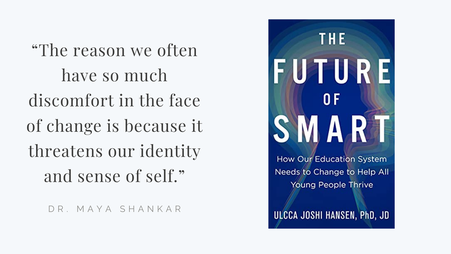 By: Dr. Cathy Collins | @Dr_CathyCollins | [email protected] Dr. Cathy Collins is currently working as a Technology Teacher (Specialist) at Sharon Middle School.Dr. Collins served on the MassCUE Board as PD Chair from 2015-2019, and has published her writing in various journals including “EdWeek,” "English Journal," “Library Media Connection,” “NEA Today,” "eSchool News" and “Knowledge Quest.” She served on the MA State Science Ambassador Team, ISTE STEM PLN Leadership Team and Mass School Library Media Association as Advocacy Chair. She was elected this past November, 2020, to serve a three year term on the ISTE Board of Directors. Book Review: “The Future of Smart: How Our Education System Needs to Change to Help All Young People Thrive" I regularly teach my 7th grade students about the Engineering Design Process through a range of hands-on and technology based activities. I emphasize that there are many approaches to problem solving, and that improvement is always possible. As I think about the current challenges of education in America, and confront the daily news about chronic student absenteeism, teacher burnout and a host of other critical issues, I’m reminded that though the list is daunting, any one of us in this business of education at any level in the system does have the opportunity to help re-imagine, rebuild and redesign toward a more learner-centered vision for education. In the words of Peter DeWitt, Ed.D., “Anyone who gets into teaching needs to believe that they can improve the educational experience for their students.” In the words of poet Emily Dickinson, “Hope is the thing with feathers.”
In “The Future of Smart: How Our Education System Needs to Change to Help All Young People,” by Ulcca Joshi Hansen, PhD, JD, we are encouraged to imagine an education system grounded in a different world view that embraces and celebrates the individual nature of human development. She illuminates systemic challenges, provides historical context and analysis of how we landed here, and shines the light forward through a holistic, learner-centered approach in which our children’s humanity and uniqueness is truly nurtured. In this transformational model, the purpose of education becomes the nurturing and crafting of identity along with the discovery of abilities that empower all students to contribute to their own and their community’s well being. I recommend this book to any educator looking to reimagine how we can best serve our children and communities. It offers a breath of fresh air and an affirmation of the value of our work as we continue to confront current limitations and systemic inequities in our current, prevailing educational model. Dr. Hansen encourages an expanded definition of “smart,” beyond “an idea based on centuries of bias about what matters in people and cultures, and what doesn’t. This idea of smart is more than just a foundation for what we do in schools; it’s one of the organizing principles of our society. And it poses an existential threat to the development of our children and our communities.” She explores throughout the book what smart should mean and what our system of education should value most, starting with “the complexity of and richness of our humanity and the many different ways in which people engage with and contribute to the world.” Hansen highlights the opportunity in the present moment without sugarcoating the difficulties inherent in transformation. “The system is reluctant to allow radical change without a clear sense of what will replace the old ways. But 2020 forced us to abandon many of our default practices, and the resulting disruptions revealed how inadequate those practices have been all along.” She ends by challenging us to apply transformational ideas with a list of suggested action steps and the charge, “The choice is ours to make.”
2 Comments
SH
2/7/2022 05:35:20 am
Just put it on my "to read" list! Sounds powerful! Thanks for the review.
Reply
Leave a Reply. |
Guest AuthorContact us at [email protected] to write for our organization! Categories |
Photo from Mike Kniec


 RSS Feed
RSS Feed